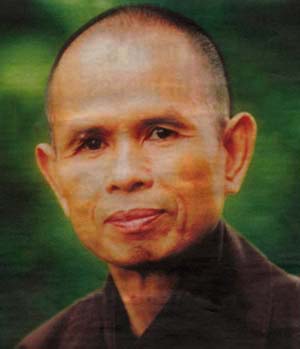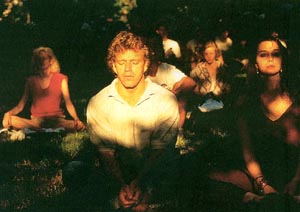 |
A Column of Catholic Orientation
Buddhism Promoted at Chicago's
Loyola University
Marian T. Horvat
Jan asked me about the ecumenism and inter-religious dialogue. Let me present a concrete example that happened recently to illustrate how such dialogue produces bad fruits.
The 5,000 seats at Loyola University stadium were sold out, and 1,000 others turned away for the August 22 event opening the school year at Chicago’s Jesuit University. What speaker stimulated such enthusiasm? What spiritual exercise could generate the kind of public interest generally reserved for sports events?

Above, Vietnamese Buddhist monk Thich Nhat Hanh packed the stadium at Loyola University to initiate students in Buddhist exercises.
National Catholic Reporter, September 12, 2003

Actualite des Religions, February 2001 |
The speaker was Vietnamese Buddhist monk Thich Nhat Hanh, who was invited by Loyola University to “instruct” Catholics on practices of Eastern pagan spirituality. Earlier that day, the Buddhist bonze gave a talk to the incoming class of 1200 Loyola freshmen and their parents at the annual freshman convocation. He encouraged his rapt audiences to the daily practice of meditation and breathing exercises as a means to eliminate all passionate emotions and thus achieve peace and compassion. He received standing ovations at both events (“Practicing Peace,” National Catholic Reporter, September 12, 2003).
A Catholic can only wonder at the irony of the situation. St. Ignatius Loyola, founder of the Jesuits, sent his missionaries around the world risking their lives to teach the Catholic Faith to pagans like the Buddhists and Hindus. Today Jesuits at a prestigious U.S. college invite a pagan monk to preach to Catholic students and parents and induce them to the practices of a gnostic pagan sect, since Vatican II benignly called “a non-Christian religion.”
Now, what would be included among those passions the monk preached against as counter-productive to peace? No doubt, the burning zeal to convert souls to the Catholic Faith that distinguished the Jesuit missionaries of times past. Everything is relative, according to the gnostic teacher. Conversion should not exist, since no one knows what is right or wrong. We should not try to change anyone’s convictions, but rather engage in “compassionate listening” to the ideas of others. This, and only this, would eliminate anger and fear and bring individual peace as well as world peace. War and harm would occur because of the conviction that one knows the truth and those who do not share his beliefs are wrong. Tolerance, the Buddhist monk assured his spellbound audience, would be the only way to bring about peace.
These are some theses from the monk’s new book, Creating True Peace, that Catholics filled Loyola stadium to hear Thich Nhat Hanh explain and teach. The students will be provided opportunity to delve deeper into the topic because they will be reading two of his works this year in Loyola’s required Great Books course.
What on earth is a Buddhist doing preaching to Catholics students at a Jesuit University? Why are students being indoctrinated at a Catholic university with the theories of a pagan sect? Buddhism rejects the dogmas of a transcendent God and Our Lord Jesus Christ as Redeemer, original sin, free will, good works, the power of prayer, the Last Judgment, Heaven and Hell. All these doctrines are disregarded as irrelevant and meaningless.
What matters to Buddhists is experience, not doctrine, thus their emphasis on self-negating meditation and asceticism. Buddhists believe in reincarnation, and seek to escape the cycles of rebirth by extinguishing all forms of desire, including attachment to conscious existence. By means of exercises like the one the Buddhist monk was teaching, they strive to attain the supposedly blissful state of nirvana, essentially, the absence of any desire.

Religious relativism of Vatican II: A Catholic priest prays in a Buddhist monastery in New York
Maryknoll, January 1999 |
It is obvious any doctrinal agreement is impossible. So where is the meeting ground for Buddhism and the progressivst Conciliar Church?
* The Buddhist emphasis on individual experience finds common ground with the Catholic Charismatic movement.
* Its religious egalitarianism – viewing all beings, human and non-human, as essentially equal in their nothingness – finds resonance in many modern philosophies that Progressivism is adapting to.
* Its radical position against any violence and all war suits the pacifist Catholic wing to a tee.
* Its preaching of tolerance for every creed, sect and moral aberration is also championed by ecumenist advocates.
So, forget any doctrine, which would be a secondary matter. That, in effect, is the message the Jesuits at Loyola are sending to their Catholic students. We could work and “pray” together with the Buddhists to achieve a more profound personal spiritual growth, as well as social goals such as world peace. By sharing experiences and keeping an open mind to other “truths,” Catholics could receive what is “good” and “holy” in the false religions. (1)
But doing this, the lines of truth and error, good and evil, holy and blasphemous become blurred, especially for young persons already acclimated to the relativist attitudes of the modern day world. As Atila Guimarães points out in Animus Delendi II,(2) for Catholic authorities to permit pantheist pagans to teach Catholics their false methods of spirituality is unacceptable on three counts:
• From the dogmatic standpoint, it denies that the Catholic Church is the exclusive guardian of the treasures of Revelation.
• It strikes at Catholic militancy, which is based on the notion of opposition between truth and error, good and evil.
• It denies the missionary character of the Church. Why the urgency to risk one’s life to bring the truth of Christ to one who already has a satisfactory, route to salvation?
If the Jesuits at Loyola University are seeking a means to stimulate a greater Catholic spirituality among youth, they would not need to look any further than the Spiritual Exercises of St. Ignatius, which has a rich history of working great conversions of individuals.
If they want to encourage students to daily meditation, they do not need to turn to Eastern breathing exercises and the recitation of mantras. Our Lady gave us the Holy Rosary, and at Fatima asked us to pray it daily as a means to save our own souls, convert sinners and achieve world peace. It is absurd to imagine that the Catholic Church has need of Buddhist practices and teachings to achieve these aims.
1. Progressivist like those at Loyola University base this novel thinking on Conciliar documents. Excerpts from the documents of Vatican Council II on ecumenism that would seem to contradict the former Catholic teaching are presented in Animus Delendi II, by Atila Sinke Guimarães, Part II, Premise II (Los Angeles: TIA, 2001), pp. 219-22. The traditional Catholic teaching on the unicity of the Faith and condemnations of ecumenism is also presented in Premise I, pp. 205-17
2. Ibid., Part II, Chapter IV, § 23, pp. 292-4.

Posted on October 22, 2003

|
Talks with Jan | Religious | Home | Books | CDs | Search | Contact Us | Donate

© 2002-
Tradition in Action, Inc. All Rights Reserved
|
 |
|